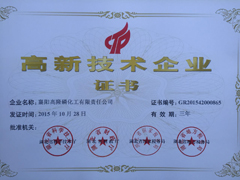新聞導航
Xiangyang Gaolong Phosphorus Chemical Co., Ltd.
Address: No. 132 South Road, Nanzhang County, Xiangyang City, Hubei Province
Tel/Fax:0710-5231641
Mobile phone: 15926890948
Contact person: Mr. wu
Mobile phone: 13377973557
Contact person: Mr. Zhou
E-mail: 13377973557@vip.163.com
Website: m.hedongzhi.com
聯(lián)系我們
13377973557Sources:Xiangyang Gaolong Phosphorus Chemical Co., Ltd. | PublishDate:2019.03.14
Excessive phosphorus and nitrogen in water will accelerate eutrophication of water body. This phenomenon is more serious in China, which has brought great harm to industry, aquatic industry, agriculture and tourism. Increased concentration of nitrogen and phosphorus is the cause of algae reproduction, and phosphorus is the key factor. Therefore, how to effectively reduce the concentration of phosphorus in sewage is of great significance for eliminating pollution and protecting the environment.
At present, domestic and foreign wastewater phosphorus removal technologies mainly include biological and chemical methods. Biological processes such as A/O, A2/O, UCT process are mainly suitable for the treatment of low concentration and organic phosphorus-containing wastewater; chemical and physical chemical methods mainly include coagulation and precipitation, crystallization, ion exchange adsorption, electrodialysis, reverse osmosis and other processes, mainly suitable for the treatment of inorganic phosphorus-containing wastewater.
However, in many industrial processes, high concentration of phosphorus-containing wastewater often appears. There is no strict definition of high concentration phosphorus wastewater in current research. It is generally considered that as long as the phosphorus content in wastewater is higher than that in domestic wastewater or the total phosphorus concentration is more than 100 mg/L, it is called high concentration wastewater. High concentration phosphorus wastewater is difficult to be removed by a single biological or chemical method, even if it can be removed, it will cause a great burden on the whole single biological or chemical treatment process, which will reduce the treatment effect of the whole treatment process or can not run continuously.
1 Source of Phosphorus in Water
Phosphorus discharged into lakes mostly comes from domestic sewage, factory and animal husbandry wastewater, fertilizer loss from forest farmland and rainfall and snow. Compared with the previous items, the phosphorus content in rainfall and snow is lower. Investigations show that the average phosphorus concentration in rainfall is lower than O.04mg/L, and in snow is lower than O.02mg/L. Taking domestic sewage as an example, the daily phosphorus discharge per person is about 1.4-3.2g, and the contribution of various detergents is about 70%. In addition, cooking and washing water, as well as phosphorus in feces and urine also have considerable content. Plant phosphorus emissions mainly come from fertilizer, medicine, metal surface treatment, fiber dyeing and fermentation and food industry. Among the phosphorus inflow, domestic sewage accounted for 43.4% of the total, the others accounted for 20.5%, 29.4% and 6.7%, domestic sewage 43.4%, factory and animal husbandry wastewater 20.5%, fertilizer loss 29.4% and snowfall 6.7%.
Forms of phosphorus in Wastewater
Phosphorus in wastewater exists in the form of orthophosphate, polyphosphate and organic phosphorus. Because of the different sources of wastewater, the total phosphorus and various forms of phosphorus content are quite different. Typical domestic sewage contains 3-15 mg/L of total phosphorus (in terms of phosphorus); in fresh raw domestic sewage, the distribution of phosphate is roughly as follows: orthophosphate 5 mg/L (in terms of phosphorus), triphosphate 3 mg (in terms of phosphorus), pyrophosphate lmg, L (in terms of phosphorus) and organic phosphorus. For these reasons, orthophosphate is the main concern in the process of phosphorus removal from wastewater. The ionization equilibrium of phosphoric acid restricts the ionization of orthophosphate in water, while producing H3P04, H2P041, HP042 1 and P04. The concentration distribution of each phosphorous group varies with the pH value. Hydrogen phosphate and dihydrogen phosphate are the main forms in typical domestic sewage with pH 6-9.
2 Chemical Treatment of Phosphorus-Containing Wastewater
Chemical precipitation method is to use a variety of cations to combine with phosphate in wastewater to form precipitation substances, so that phosphorus can be effectively separated from wastewater; electrodialysis phosphorus removal is a membrane separation technology, it is only a method of concentrating phosphorus, it can not fundamentally remove phosphorus itself; biological method is now mostly used in the situation of low phosphorus content in municipal wastewater treatment plants. Compared with other methods, chemical precipitation method has the advantages of high operating flexibility, high phosphorus removal efficiency and simple operation.
I. Phosphorus Removal by Calcium Method
Among the precipitation methods for phosphorus removal by calcium method, the main chemical precipitators are aluminium ion, iron ion and calcium ion. Among them, the equilibrium constant of hydroxyapatite formed by lime and phosphate is the largest and the effect of phosphorus removal is the best. When lime is added to wastewater containing phosphorus, calcium ion reacts with phosphate to form precipitation. The reactions are as follows: 5Ca2 +7OH-+3H2PO4-=Ca5 (OH) (PO4) 3+6H(1) side reaction: Ca2 +CO32-=CaCO3(2) reaction (1) The equilibrium constant KS0=10-55.9. From the above reaction, it can be seen that the phosphorus removal efficiency depends on the relative concentration of anions and pH value. Formula (1) shows that phosphate reacts with calcium ions under alkaline conditions to form calcium hydroxyphosphate, and the reaction tends to be complete with the increase of pH value. When the pH value is greater than 10, the phosphorus removal effect is better and the mass concentration of phosphate in effluent can be ensured to be less than 0.5mg/L. Reaction (2) means that calcium ions react with calcium ions. The formation of calcium carbonate by carbonate reaction in wastewater is very important for phosphorus removal by calcium method. It not only affects the dosage of calcium, but also produces calcium carbonate which can be used as a weight-increasing agent to condensate and clarify wastewater.
The primary reaction and precipitation in the above process are mainly zinc removal, control of pH=8.5-9.0, adding polyaluminium chloride. The second reaction and precipitation are mainly phosphorus removal by calcium method, and control of pH=11-11.5. The effluent is discharged or reused after neutralization, and the effluent quality reaches the first level standard.
Key technologies:
The key technology of phosphorus removal by calcium method is using calcium chloride or lime as reagent, using mechanical mixing reactor and high efficiency inclined tube precipitator to control appropriate reaction, mixing strength, precipitation surface load and reaction pH value.
Two commonly used phosphorus removal substances:
1. slag
Slag is a solid waste produced in the process of iron and steel smelting. It is mainly composed of CaO, FeO, MnO, SiO 2, Fe2O3, P2O5, Cr2O5, Al2O3 and other oxides. It has many excellent characteristics. Each component can be used. The experimental study of this method is to add 200 mL simulated phosphorus-containing wastewater and a certain amount of slag to several plug-cone bottles, which are placed on an oscillator and oscillated at room temperature. The adsorption reaction is filtered after reaching equilibrium at a fixed time, then the concentration of phosphorus in the clear solution is tested, and then the adsorption amount and phosphorus removal rate on the adsorbent are calculated by comparing the initial concentration and equilibrium concentration of phosphorus in the solution. Research shows:
(1) With the increase of slag dosage, the removal rate of phosphorus increases, but the adsorption capacity decreases.
(2) The adsorption capacity increases with time at the beginning, but it tends to be stable when the adsorption time is longer than 2 hours.
(3) The adsorption capacity increases with the increase of phosphorus concentration in wastewater.
(4) Temperature has little effect on slag adsorption.
(5) The pH value of the solution has an important influence on the adsorption effect. When the pH value is 7.56, the removal rate of phosphorus is the highest.
Therefore, when the concentration of phosphorus in waste water is 2-13 mg/L, the dosage of slag is 5 g/L, the pH is 7.56, and the adsorption time is 2 h, the removal rate of phosphorus can reach more than 99%, the concentration of residual liquid is also lower than the national discharge standard, and the method is safe and reliable, and will not produce secondary pollution.
2. Adding Lime
When a large amount of lime is added to the wastewater containing phosphorus, hydroxyapatite is formed by adjusting the pH value to 10.5-12.5. The precipitate is stable and the equilibrium constant is large. The equilibrium constant of Ca10(OH)2(PO4)6 is 90, which is 3-4 times larger than that of phosphate precipitate formed by aluminium and iron salts.
The larger the equilibrium constant is, the more stable the precipitate is, the better the precipitation effect is, the more thorough the dephosphorization is, the better the solid-liquid separation effect is, and the treatment of phosphorus-containing wastewater is up to the standard, P < 0.5mg/L. Adding lime can improve the pH value of wastewater and remove phosphorus, at the same time, the co-precipitation of petroleum and CODcr in wastewater can be purified, and the wastewater can meet the discharge standards. The sludge produced by lime treatment of phosphorus-containing wastewater is large. Sludge from the bottom of inclined-tube sedimentation tank is discharged into sludge concentration tank through bottom pipe, and the sludge is discharged 1-2 times a day, so as to avoid dry plugging. After the sludge concentration tank is concentrated, the lower thick sludge is pumped into the plate and frame filter press and filtered to separate the solid and liquid, and the dry slag is packed and transported.
3. Mixture-assisted chemical precipitation
The compound precipitator used in this method is magnesium chloride and ammonium hydrogen phosphate, which can produce slow-acting compound fertilizer while removing phosphorus. The reaction principle is as follows:
HPO42-+Mg2+ NH4++ 6H2O = MgNH4PO4 +H+
PO43-+Mg2+ NH 4++ 6H 2= MgNH 4 PO4 6H 2 reacts to produce MgNH 4 PO4 6H 2, which is easy to filter. For wastewater with low phosphorus concentration, the discharge standard can be achieved by one treatment. However, when treating wastewater with high phosphorus concentration, it is difficult to reach the standard. It is necessary to add composite coagulant PAC (polyaluminium chloride) and PAM (polyacrylamide ammonium). The coagulation of PAC is mainly through. PAM is an anionic macromolecule flocculant, which can be dispersed quickly and evenly after adding solution to form flocculant by bridging precipitation ions in aqueous solution and precipitating them [4]. The experimental results show that PAM can be used as coagulant assistant and cooperate with coagulant PAC to achieve good coagulation effect. Compound coagulation is used.
CHARACTERISTICS OF CHEMICAL PHOSPHORUS REMOVAL METHOD
Chemical phosphorus removal is essentially a physical and chemical process. Its advantages are stable and reliable treatment effect, simple operation and high elasticity, sludge will not re-release phosphorus in the process of treatment and disposal, and the ability to withstand impact load is also strong. The disadvantage is that chemical phosphorus removal process will produce a large number of water-bearing chemical sludge, which is difficult to treat. In addition, the higher the cost of the reagent, the higher the concentration of residual metal ions and the higher the chroma of the effluent.




